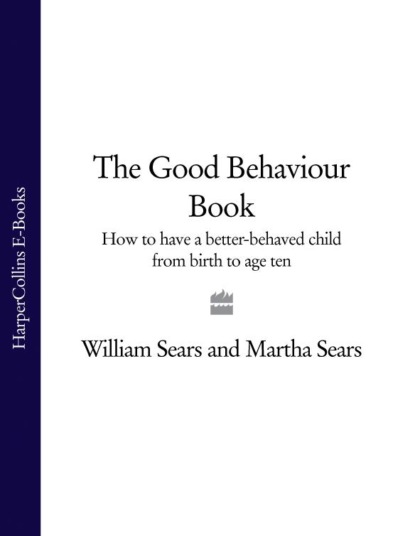По всем вопросам обращайтесь на: info@litportal.ru
(©) 2003-2024.
✖
The Good Behaviour Book: How to have a better-behaved child from birth to age ten
Автор
Год написания книги
2018
Настройки чтения
Размер шрифта
Высота строк
Поля
Some parents fail to set limits because they can’t stand to see their baby frustrated. Healthy doses of frustration help a baby have just the right amount of resistance to keep him reaching for his full potential. No frustration, no growth. All frustration, no life. Be sure you model the healthy way to handle frustration. Adults have limits, too. If you know how to deal with your limits, you’ll know how to provide limits for your baby. Attachment parenting doesn’t imply you won’t have parent-child conflicts, yet it prepares you to better handle them.
Toddlers want someone to set limits. Without limits the world is too scary for them. They intuitively know they need the security that limits bring. When they test the limits they are asking you to show them how dependable you and your limits are.
Take charge. As each of our babies graduated into toddlerhood, we had to examine our roles as authority figures – what that meant and how we would maintain that status. We wanted to be clearly in charge of our toddlers so that they would feel safe and secure with someone standing between them and the dangers of the big world, with a place to go for help. We didn’t want to control them like puppets so that we ourselves could feel powerful. And contrary to the opinion of some theorists, we did not believe that our toddlers wanted to control us. It was themselves that they wanted to learn to control. We helped them in two ways: by letting them know by our tone of voice and our actions that we are mature adults, and by being available as a safe and secure home base that they could leave and return to at will, exploring the world then returning for comfort and reassurance when needed. In this way we could help them develop their own inner controls.
helping your child play alone
Part of self-discipline is the ability to enjoy playing alone. Before eighteen months of age, a baby will do this only in short spurts and will be eagerly checking in with mother frequently, either physically coming to her or finding her with his eyes. Attachment-parented babies may prefer to be in touch with mother almost constantly, and this is healthy. It seems as though allowing the baby to have his fill of mother’s presence as an infant and young toddler prepares him for time on his own. He will know how to manage himself and won’t need to be entertained as much as the baby who is not well connected.
The time between the ages of fourteen and eighteen months is very hard for mothers. The high-energy toddler wants to do everything, but he still needs mother involved “big time”. Mothers of one-year-olds need to gear up for this marathon spurt of giving, because the tendency is to think, “Ah, now he’s one – I’ll be able to ease off.” You will eventually, but not yet. Hang in there through age eighteen months, then be alert for signs that your toddler is trying to make space between you. Some mothers might tend to hover and smother and continue to hang on, but remember, the one-and-a-half-to-two-year-old needs to become his own person. You will see these efforts more and more. At first you won’t believe your eyes. Your toddler will do what he sees you doing. She will tend doll babies, get out pots and pans, want to play at the sink, dig in the dirt with spoons. You name it – the possibilities are endless. She’ll want you to pretend with her a bit. It’s fun to be a dog or a lion, but she really only needs you to get her started. Pretend tea parties or picnics where you gobble up everything she hands you don’t require much involvement from you.
By age three, a child’s imagination and creativity will allow him to be able to have fun with anything. Keep toys simple and basic – building blocks, balls, dolls and blankets, cars and trucks (no batteries please). A four-year-old alone in a room with nothing to play with will figure out how to use shoes and socks as cars and people or as cradles and dolls.
By the time your child is six, you will have reached what one psychologist we talked to calls “planned detachment”. Your child will look in for breakfast, go out the door, look in for lunch, and be gone again. You’ll say, “You’re looking well, dear”, you’ll write a note to remind him of chores, and finally at dinner you’ll get to talk a little. After dinner some card playing, singing, or other family-oriented activity reconnects you with this individual who used to stick to you like Velcro.
We gave our toddlers chances to mess up. They learned from their parent-supported failures. When Stephen insisted on having juice in an open cup with no help from Martha, she let him try it, and he spilled it all over himself. The cold juice running down his body startled him. For the next sip he was willing to be less impulsive; he listened closely to Martha’s advice to tip the cup “slowly”. Because of the mutual trust and sensitivity that we developed during their first year, it was easier for our toddlers to respect us as authority figures. We were able to convey to them what behaviour we expected, and their actions often showed that they wanted to please themselves by pleasing us.
Once we reach that level of discipline, we feel tremendous job satisfaction. This is really what discipline is all about. It is not what we are doing to our children, it is what we are doing for and with them, and what they are doing for themselves.
providing structure (#ulink_f30a8782-3795-5f60-9910-d546b5f630ca)
When your child reaches one year of age, another tide is added to the parenting job description: architect of your child’s environment. By taking on this job you steer the child’s energies toward enjoyable learning experiences and away from harm. You create structure, which does not mean being inflexible, repressive, or domineering. On the contrary, what we mean by “structure” is setting the conditions that encourage desirable behaviour to happen. Structure protects and redirects. You free the child to be a child and provide the opportunity to grow and mature. Structure creates a positive environment for the child. By a bit of preplanning you remove most of the “nos” so that a generally “yes” environment prevails.
Structure changes as the child grows. At all developmental levels restructuring the child’s environment is one of your most valuable discipline strategies. When your infant reaches the grabby stage, you are careful to set your coffee cup out of his reach. When your toddler discovers the toilet, you start keeping the lid latched or the bathroom door closed. The preschooler who fights going to sleep at night gets a relaxing bedtime routine. The nine-year-old struggling to keep up with her homework gets a quiet, enticing place to work in, as well as firm restrictions on school-night television. Structure sets the stage for desirable behaviours to override undesirable ones.
Create a toddler-friendly, toddler-safe environment. Toddlers get frustrated easily trying to live in a house furnished only for bigger bodies. Your role as designer of your child’s environment involves making your house safe for your toddler and safe from your toddler. Toddlers are full of interest. Your job is to facilitate that interest safely. This is much easier to do at home, of course. When a child sees something enticing and sparkly, he will naturally want to touch it. It’s the parent’s job to get down and help the child explore that object without damaging it, or himself, and then redirect the child’s attention.
Putting away the breakables and the family heirlooms in your home is not a capitulation to toddler power; it is simply a way to avoid having to be constantly on guard and having to always say no to your child, causing a build up of frustration and anger in both of you. This is a much better alternative to being ever watchful and protective, or punitive toward a natural urge to explore. You, as the adult, have the maturity to put your own things aside (up or away) for a while until your child has the maturity to respect adult valuables. Keep in mind that this is only for a short time. We found that when our babies mastered crawling, we had to remove all our plants from floor level. Six months later we put the plants back down and the babies completely ignored what had been irresistible before. When your child starts to crawl, take a tour of your house from his perspective to discover what needs childproofing. There are many inexpensive products available that will help you make your home safe for your child (toilet seat latches, door-knob covers, drawer and cupboard latches, electric socket and plug covers, and so on). These and some ingenuity will enable you to protect your little scientist. Effort spent baby-proofing your home will pay off in less conflict with your toddler. Plus, you will be more relaxed parents. Childproofing also provides your young explorer with guidance from the controlled environment itself. Here’s a room-to-room guide to start with:
Living room/family room:
• Cover electrical sockets.
• Secure lamp cords so lamps can’t be pulled down.
• Anchor floor lamps, or remove them.
• Cover controls on the television, stereo, DVD or video.
• Cushion sharp corners on coffee tables and hearths.
• Display breakables out of baby’s reach, or put them away for a few years.
• Reorganize bookshelves (toddlers love to empty these, tearing covers and dust jackets).
• Move plants.
Dining room/eating area:
• Push chairs all the way up to the table to prevent climbing.
• Install latches on drawers or cupboards holding breakable dishes.
• Push items on the tabletop to the centre.
• Fold tablecloth corners under and up, out of grabbing distance.
Bathroom:
• Keep medicines, razors, pins, mouthwash, cosmetics, perfume, nail polish and remover, scissors, and other dangerous objects out of reach.
• Keep medicine cabinet latched.
• Pad bath taps.
• Place a non-slip mat in the bath.
• Use rugs with non-slip backings.
• Keep the toilet seat down and latched.
• Empty the bath after use. Don’t leave children unattended in the bath.
• Use plastic, not glass or ceramic, cups and soap dishes.
• Keep the bathroom door shut.
Kitchen:
• Store knives out of reach.
• Unplug small appliances. Don’t leave cords dangling.
• Store cleansers, solvents, bleaches, dishwasher detergent, and other poisons out of baby’s reach in a latched cupboard.
• Cook on the back burners, and turn pot handles toward the back.
• Cover the hob controls, or remove them.
• Store breakables, things your baby can choke on, and other dangerous objects out of reach. Remember, that toddlers can climb onto kitchen surfaces.
• Use unbreakable dishes when your baby is around.
• Store plastic bags and plastic grocery bags out of reach.
• Hold hot drinks where your baby can’t grab them, and keep them away from the edge of tables or counters.
Windows and doors:







